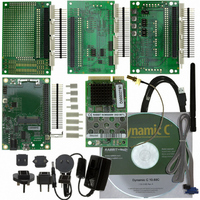101-1285 Rabbit Semiconductor, 101-1285 Datasheet - Page 55

101-1285
Manufacturer Part Number
101-1285
Description
DEV KIT DELUXE MINICORE RCM5600W
Manufacturer
Rabbit Semiconductor
Series
MiniCore™r
Type
Transceiver, 802.11 b/gr
Datasheet
1.101-1285.pdf
(130 pages)
Specifications of 101-1285
Frequency
2.4GHz
Processor To Be Evaluated
Rabbit 5000
Processor Series
RCM5600W
Interface Type
RS-232, USB, PCI
Maximum Operating Temperature
+ 55 C
Minimum Operating Temperature
- 30 C
Operating Supply Voltage
3.15 V to 3.45 V
Silicon Manufacturer
Rabbit Semiconductor
Silicon Family Name
RabbitCore
Kit Contents
Board
Features
On-board Single-Chip 802.11b/g Transceiver, Built-In Web Server
Development Tool Type
Hardware /
Rohs Compliant
Yes
For Use With/related Products
RCM5600W
Lead Free Status / RoHS Status
Not applicable / Not applicable
Other names
316-1161
6. U
W
-F
F
SING THE
I
I
EATURES
6.1 Introduction to Wi-Fi
Wi-Fi, a popular name for 802.11b/g, refers to the underlying technology for wireless local
area networks (WLAN) based on the IEEE 802.11 suite of specifications conforming to
standards defined by IEEE. IEEE 802.11b describes the media access and link layer control
for a 2.4 GHz implementation, which can communicate at a top bit-rate of 11 Mbits/s. Other
standards describe a faster implementation (54 Mbits/s) in the 2.4 GHz band (802.11g).
The adoption of 802.11 has been fast because it's easy to use and the performance is com-
parable to wire-based LANs. Things look pretty much like a wireless LAN.
Wi-Fi (802.11b/g) is the most common and cost-effective implementation currently avail-
able. This is the implementation that is used with the RCM5600W MiniCore module. A
variety of Wi-Fi hardware exists, from wireless access points (WAPs), various Wi-Fi
access devices with PCI, PCMCIA, CompactFlash, USB and SD/MMC interfaces, and
Wi-Fi devices such as Web-based cameras and print servers.
802.11b/g can operate in one of two modes—in a managed-access mode (BSS), called an
infrastructure mode, or an unmanaged mode (IBSS), called the ad-hoc mode. The 802.11
standard describes the details of how devices access each other in either of these modes.
6.1.1 Infrastructure Mode
The infrastructure mode requires an access point to manage devices that want to communi-
cate with each other. An access point is identified with a channel and service set identifier
(SSID) that it uses to communicate. Typically, an access point also acts as a gateway to a
wired network, either an Ethernet or WAN (DSL/cable modem). Most access points can
also act as a DHCP server, and provide IP, DNS, and gateway functions.
When a device wants to join an access point, it will typically scan each channel and look
for a desired SSID for the access point. An empty-string SSID (" ") will associate the
device with the first SSID that matches its capabilities.
Once the access point is discovered, the device will logically join the access point and
announce itself. Once joined, the device can transmit and receive data packets much like
an Ethernet-based MAC. Being in a joined state is akin to having link status in a
10/100Base-T network.
802.11b/g interface cards implement all of the 802.11b/g low-level configurations in firm-
ware. In fact, the 802.11b/g default configuration is often sufficient for a device to join an
OEM User’s Manual
49




















